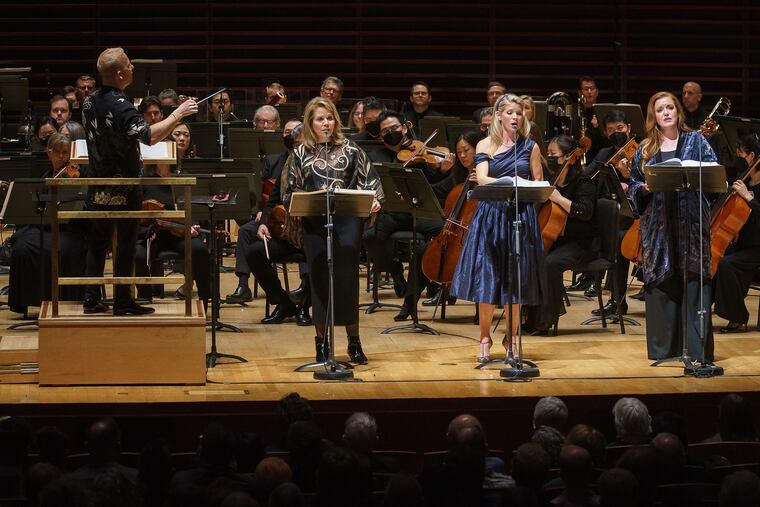Philadelphia Orchestra premieres ‘The Hours.’ Next stop: Metropolitan Opera.
"The Hours" — not the book or the movie — becomes a penetrating opera despite near-impossible odds. The opera-in-concert presentation, repeated Sunday at Verizon Hall, can be safely called historic.

No operatic team takes on a literary property as deep and complicated as The Hours without having a viable plan for theatrically blending its three psychologically penetrating stories that take place all over the 20th century. But composer Kevin Puts, librettist Greg Pierce, and an all-star cast with the Philadelphia Orchestra beat the next-to-impossible odds in an operatic adaptation of the famous Michael Cunningham novel and 2002 film in the premiere Friday at the Kimmel Cultural Campus.
The opera-in-concert presentation, repeated Sunday at Verizon Hall, can be safely called a historic event. Though something of a preview for a full production next season at the Metropolitan Opera, there was no sense that this is a work in progress, so fully realized was the opera’s treatment of the three parallel plots, as well as the performances by Renee Fleming, Kelli O’Hara and Jennifer Johnson Cano under Yannick Nézet-Séguin. The near-full audience that cheered the opera’s concluding, mesmerizing, three-soprano trio would no doubt agree.
Without lowering the brow of the story, the opera is immediately lovable, with a lush orchestration that hits you in the solar plexus — plus an ever-present chorus that sings what everybody is thinking, and had the Philadelphia Symphonic Choir deftly blended with the textures of the orchestra.
Harmonically, the opera reflects influences from John Adams — as do so many pieces by many current composers — though composer Puts has a more precise dramaturgical sense than Adams, and a tougher edge that’s demanded of the opera’s three stories: about author Virginia Woolf writing her famous novel Mrs. Dalloway in the 1920s; a suicidal housewife reading the novel in the 1940s; and an AIDS caregiver living the novel in the 1990s. Thanks to the kind of magic realism that’s possible in opera, the different stories overlap, unfold simultaneously and ultimately have powerful dialogues with each other, thanks to Puts’ mastery of high-def, big-screen sound pictures and librettist Pierce’s smart choices in drawing from the huge possibilities of the source material. Surtitles were full of plot signposts that saved this operatic package from potential confusion.
And as one who followed the opera easily from having studied the film and Puts’ score, I was pleased to talk to concert goers who had no background in The Hours but had no problem navigating its constantly shifting sands.
Of course, Puts’ broad musical vocabulary is very much responsible for telling the stories on visceral and subliminal levels. Big turning points arrived with both grandeur and detail, so much that a good orchestral suite could be drawn from this score, starting with the Act I prelude, suggesting Debussy in his darker, Edgar Allen Poe-influenced moments. But the opera’s hallmark was more intimate moments that achieved gut-wrenching intensity equal to the best of Puccini, but with an extra ring of truth. Those who have lived through similar stories — including the 1990s AIDS epidemic — might find that this opera goes knowingly into the core issues of that time.
Each main character had an individual sound world: Virginia Woolf’s being spare with good use of silence, often implying more than the music said and an occasional dash of Ralph Vaughan Williams. Laura, the housewife, had music with a surface luster suggesting a materialistic world of post-war plenty plus whiffs of 1950s pop music. The latter-day Mrs. Dalloway of the 1990s was a common musical meeting ground, a nerve center of sorts, and with plenty of nervous rhythm, of course.
Fleming and O’Hara had the luxury of having their roles written specifically for them, which was reflected in any number of arresting moments, though both were still in the process of wrapping their voices around some of the contours of their vocal lines. Cano’s portrayal of Woolf was 100% there: Every word was clear both in content and intention, and her mezzo-soprano tone was deeply alluring. Equally excellent in similar ways was Brett Polegato as the AIDS-stricken Richard. Even small rolls were fully realized, including Jonah Serotta as Laura’s son Richie. The orchestra under Nézet-Séguin played the score as if it had lived with the music for years (as opposed to days, which was actually the case).
A historic event indeed, and one that stands with Jennifer Higdon’s blue cathedral (2000), Michael Hersch’s The Vanishing Pavilions (2005) and Julia Wolfe’s Anthracite Fields (2014) as great beacons of artistic truth that were first heard in Philadelphia.
The Hours will be repeated at 2 p.m. Sunday in Verizon Hall. Tickets: $53-$165. Information: www.philorch.org or 215-893-1999.